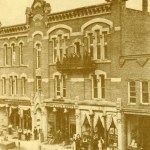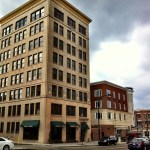- Kaiser Hall, 2013
- Kaiser Hall, 1870s
By James Caprio
The Kaiser Building (or Kaiser Hall) was built in 1871, just six years after the end of the Civil War. Built by successful Akron businessman Joseph Kaiser, the building’s design was modeled after the High Victorian Gothic style popular in Europe in the middle 1800s. The features of this style are the running bond red pressed brick, high arching windows with contrasting limestone trim, and gabled roofs (which have since been removed from the building). After the building was completed in 1877, Kaiser Hall and its adjacent buiildings became known as Kaiser’s Block. Joseph Kaiser operated a hardware store on the street level, selling tools, stoves, and copper and sheet iron products. Kaiser lived in the luxury loft above his store. The third level of the building was used as a grand ballroom. Kaiser leased out one half of the building to Charles Myers, who ran the company Holloway and Myers. Holloway and Myers sold hats, boots, and shoes. Myers also resided in the building on the upper level. In 1891, Kaiser’s hardware store was taken over by John Gross, who continued the hardware store at the site until the 1940s. Since then, the building has seen its share of various businesses come and go. In recent history, the building was purchased by JJC Investors in 2005, however they were unable to renovate or sell the building. They even tried to sell the building on E-Bay, yet were unsuccessful. The building was then bought by Tony Troppe and the Kaiser Hall Revival Group and has since been renovated and re-opened as a site for businesses.


















